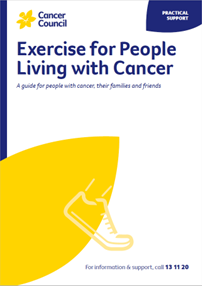- Home
- About Cancer
- Living well
- Exercise for people living with cancer (with videos)
- Why exercise is important
Why you need exercise after a cancer diagnosis
If you have cancer, or are having treatment or recovering, you may think that you just need rest. But research shows that exercise benefits most people with cancer before, during and after treatment.
Learn more about:
- Overview
- What are the benefits of exercise?
- How much exercise should I do?
- Video: Exercise and cancer
Overview
Many people with cancer lose fitness, muscle mass and strength, and find it harder to do normal everyday tasks. Exercise can improve physical function and fatigue and help you regain strength to get back to your daily activities.
What are the benefits of exercise?
Exercise is important for everyone’s overall health and wellbeing, but it has a range of general benefits for people with cancer. It may:
- improve how you respond to treatment (for some cancers)
- reduce the risk and severity of side effects of cancer treatments
- reduce complications from surgery and time spent in hospital
- help with recovery from treatment by increasing energy levels, reducing treatment-related muscle loss, strengthening bones, and improving mobility and balance
- improve sleep and fatigue, and relieve stress, anxiety and depression
- help maintain a healthy weight
- reduce the risk of developing or improve health issues, such as high blood pressure, heart disease, stroke, osteoporosis and type 2 diabetes
- reduce the risk of some cancers coming back, including breast, prostate, bowel and endometrial (uterine) cancers
- boost mood and self-esteem
- offer new ways to meet people and socialise.
How much exercise should I do?
| Why is exercise important for cancer patients? | The Clinical Oncology Society of Australia (COSA) recommends that exercise should be prescribed to all cancer patients as a standard part of their cancer care to help manage the effects of cancer and its treatment. Exercise & Sports Science Australia (ESSA) also encourages people with cancer to exercise. |
| How active should cancer patients be? | Aim to be as physically active as your abilities allow. Exercise for people living with cancer should be tailored to the type and stage of cancer and any side effects. Talk to an exercise professional (an accredited exercise physiologist or physiotherapist) or a clinical nurse consultant about how much and what type of exercise is best for you. |
| COSA’s exercise recommendations for cancer patients |
COSA recommends that people with cancer who are relatively healthy and have been assessed as low risk, aim for and maintain per week:
|
| How to safely build up your exercise routine |
It can take time to build up to this level of exercise. After treatment, aim to gradually increase exercise to Australia’s Physical Activity and Sedentary Behaviour Guidelines for Adults, which recommend you:
|
→ READ MORE: Treatment side effects and exercise
Video: Exercise and cancer
Podcast: Meditation and Relaxation
Listen to more of our meditation and relaxation podcast for people affected by cancer
More resources
Kirsten Adlard, Accredited Exercise Physiologist, The University of Queensland, QLD; Dr Diana Adams, Medical Oncologist, Macarthur Cancer Therapy Centre, NSW; Grace Butson, Senior Physiotherapist, Peter MacCallum Cancer Centre, VIC; Kate Cox, 13 11 20 Consultant, Cancer Council SA; Wai Yin Chung, Consumer; Thomas Harris, Men’s Health Physiotherapist, QLD; Clare Hughes, Chair of Cancer Council’s Nutrition, Alcohol and Physical Activity Committee; Jen McKenzie, Level 1 Lymphoedema Physiotherapist, ESSA Accredited Exercise Physiologist, The McKenzie Clinic, QLD; Claudia Marck, Consumer; Dr David Mizrahi, Accredited Exercise Physiologist and Research Fellow, The Daffodil Centre at Cancer Council NSW and The University of Sydney, NSW; Prof Rob Newton, Professor of Exercise Medicine, Exercise Medicine Research Institute, Edith Cowan University, WA; Jason Sonneman, Consumer.
View the Cancer Council NSW editorial policy.
View all publications or call 13 11 20 for free printed copies.

